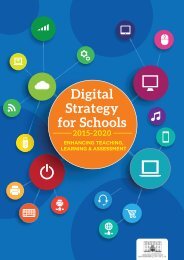K3zgZ
K3zgZ
K3zgZ
Create successful ePaper yourself
Turn your PDF publications into a flip-book with our unique Google optimized e-Paper software.
TRADOC Pam 525-8-2<br />
competencies that can be further tailored to suit operational and position needs as determined by<br />
the learner and unit commander.<br />
b. Upon initial entry to the Army, individuals begin a career path trajectory with both<br />
mandatory gates and discretionary learning events throughout their careers. Certain career<br />
events will become trigger points for additional learning, civilian schooling, or broadening<br />
experiences. Individual career guidelines and options for divergence will be available online to<br />
empower Soldiers to assume more responsibility for individual career development. The<br />
relationship between learner and schoolhouse ceases to be an episodic event, but is instead a<br />
career-long partnership. This partnership extends to the unit supervisor who will possess tools to<br />
guide learning experiences tailored to the Soldiers’ experience level and unit performance<br />
requirements. Learning continues at unit locations through learning content that is both pushed<br />
by the schoolhouse and pulled by the learner, mandatory and self-directed, competency-based,<br />
and set to established gates.<br />
c. To achieve desired outcomes of the career span framework, career field proponents must<br />
clearly identify the desired 21st century Soldier competency levels and assessment metrics for<br />
each cohort and echelon. For example, consider what qualities of critical thinking and problem<br />
solving are essential at the initial entry level, and to what degree these competencies<br />
progressively develop through the career. This requires a comprehensive review of career span<br />
learning outcomes as synchronized with operational performance needs across the nine 21st<br />
century Soldier competencies. Instructional design principles guide decisions between face-toface<br />
vice technology-delivered instruction, and resident vice nonresident learning events.<br />
d. The career span framework includes a blend of relatively standardized foundational<br />
learning and personalized learning that fit the Soldier’s specific career needs. Standard,<br />
foundational competencies are critical at the initial entry level, intermediate level, and the<br />
strategic level of career development. The current mid-grade courses will transition to a modular<br />
learning approach tailored to assignments and operational needs. Appendix E provides course<br />
level descriptions at each career level. At each level, the cohort proponent also establishes<br />
civilian education degree requirements. Functional courses provide additional specialized skills<br />
appropriate for the individual career path and assignments. Some continuous adaptive learning<br />
model instructional guidelines are common across all levels of instruction and should be applied<br />
as appropriate to the learning content and audience. Instructional guidelines are outlined in<br />
figure 3-4, followed by specific career span guidelines for each cohort and echelon.<br />
(1) Initial entry level. Soldiers and junior officers enter the career path trajectory at a<br />
resident training center where direct observation and performance feedback is critical to<br />
developing initial military skills and moral strength. IMT is a rigorous, foundational learning<br />
experience that combines indoctrination into the Army culture, which rests on the<br />
interdependence between the distinctive values, character, and identity that comprise the Warrior<br />
Ethos, and basic skills training and comprehensive fitness. It is here that the Army also instills a<br />
24




